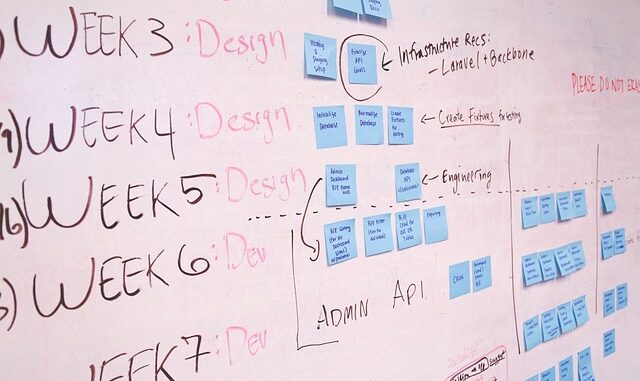
Summary
This article provides a comprehensive, seven-step guide to effective project planning. It emphasizes clear objectives, task breakdown, resource allocation, timelines, communication, risk management, and continuous improvement. By following these steps, you can navigate the complexities of project planning and achieve successful outcomes.
Find out how Focus360 Energy helps with energy statements for planning.
** Main Story**
Project planning? Yeah, it’s honestly the bedrock of any project that actually succeeds. A solid plan? It’s like giving your team a superpower. They can dodge curveballs, nail deadlines, and hit goals, all while looking like they know what they’re doing (even if we sometimes don’t!). So, let’s dive into seven actionable steps that can seriously boost your project planning game and, ultimately, help you steer those projects toward victory.
Step 1: Crystal Clear Objectives – No Fuzzy Thinking Allowed
First things first, you’ve got to know exactly what you’re trying to achieve. What’s the point of this whole project anyway? What outcomes are you hoping for? Spend the time to clearly define your project’s objectives and goals. Make sure they’re not just vague ideas, but measurable and achievable targets. This clarity is the bedrock, it’s absolutely crucial, and it’s what gets everyone on the same page from the jump.
Think of it like this: I once worked on a project where the initial goal was simply “improve customer satisfaction.” Vague, right? We ended up spinning our wheels for weeks until we redefined it as “increase Net Promoter Score by 15% within six months.” Suddenly, we had something concrete to aim for.
Step 2: Chop It Up – Deconstruct the Project
Big projects? They can feel like climbing Mount Everest in flip-flops. The solution? Break it down. Deconstruct those massive tasks into smaller, more manageable chunks. It makes the whole thing way less overwhelming and makes task assignments and progress tracking so much easier. Each task should have a clear owner and a defined set of deliverables. No ambiguity allowed.
Step 3: Time is of the Essence – Craft a Detailed Timeline
A project timeline is like your GPS on a road trip. It’s essential for staying on track. Figure out the start and end dates for each task and identify any dependencies between tasks. This timeline provides a roadmap for project execution and lets you spot potential roadblocks before they become disasters. Seriously, think about using project management tools with Gantt chart functionality. Visualizing your schedule makes a world of difference.
Step 4: Resource Allocation – Be Smart With What You’ve Got
What resources will you need to complete the project, do you have the budget, the right tools and technology? Effective project planning means knowing exactly what you need to work with, and allocating them carefully. A well-defined budget, one that considers all potential expenses, can help prevent cost overruns. And please don’t forget a contingency plan for the inevitable, unexpected costs or resource constraints. Because, let’s be real, something always goes wrong.
Step 5: Talk, Talk, Talk – Cultivate Open Communication
Communication and collaboration, they’re like the secret sauce of project success. Set up clear communication channels and encourage open dialogue between team members, stakeholders, and clients. Regular updates, progress reports, and feedback sessions? They keep everyone in the loop. This open communication fosters a collaborative environment and reduces the risk of misunderstandings. It’s also a great way to catch potential problems early on, before they snowball into major headaches.
Step 6: Keep an Eye On It – Monitor and Adapt
Project planning isn’t a “set it and forget it” kind of deal. Regularly monitor your project’s progress against the plan. Track task completion, resource utilization, and budget adherence. Be ready to tweak your plan when you face unforeseen challenges, scope changes, or new information. Flexibility and adaptability are essential for keeping your project on course. Because, let’s face it, plans rarely survive first contact with reality.
Step 7: Learn From Your Mistakes – Embrace Continuous Improvement
Once the project is done, take some time to look back. What worked well? What could you have done better? These post-project reviews are invaluable for learning from past experiences and refining your planning process. Document these lessons learned and put them into your project planning methodology. I’m telling you, that knowledge is power!
Following these seven steps can help you create a robust and adaptable project plan that sets you up for success. And look, don’t forget: effective project planning is an ongoing process. Keep improving, and learn from every project, even the ones that go sideways. You’ll be a project planning pro in no time.


The emphasis on clear objectives is well-placed. Could you elaborate on strategies for ensuring all stakeholders share a unified understanding of these objectives from the outset, particularly in projects with diverse teams and priorities?
Great point! Getting everyone on the same page from the start is crucial, especially with diverse teams. We’ve found that workshops where stakeholders collaboratively define objectives and key performance indicators (KPIs) can be really effective. It fosters shared ownership and uncovers potential conflicts early on. What strategies have you seen work well in your experience?
Editor: FocusNews.Uk
Thank you to our Sponsor Focus 360 Energy